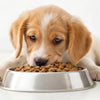How Much Dry Dog Food for an 80 Pound Dog: A Comprehensive Guide
- Houndsy
Table of Contents
- Introduction
- Factors Affecting Dog Food Portions
- Recommended Daily Food Intake for an 80-Pound Dog
- Importance of Quality Ingredients
- Understanding Your Dog's Body Condition
- Feeding Schedules and Tips
- The Role of Houndsy in Elevating the Feeding Experience
- Conclusion
- Frequently Asked Questions (FAQs)
Introduction
Did you know that approximately 59% of dogs in the United States are classified as overweight or obese? This startling statistic highlights the importance of understanding how much dry dog food to feed our furry friends, particularly for larger breeds. If you have an 80-pound dog, you might be wondering how to ensure that they receive the right amount of food to maintain a healthy weight and optimal well-being.
In this blog post, we will explore the various factors that influence how much dry dog food an 80-pound dog should eat. By the end, you will have a clear understanding of the recommended feeding guidelines, how to choose the right food, and how to adjust portions based on your dog's individual needs. We’ll also introduce you to Houndsy’s innovative products, designed to enhance your pet care routine and make feeding time a breeze.
We will cover the following topics:
- Factors Affecting Dog Food Portions
- Recommended Daily Food Intake for an 80-Pound Dog
- Importance of Quality Ingredients
- Understanding Your Dog's Body Condition
- Feeding Schedules and Tips
- The Role of Houndsy in Elevating the Feeding Experience
- Conclusion
- Frequently Asked Questions (FAQs)
Let’s dive in and ensure that we’re providing the best care for our beloved canine companions!
Factors Affecting Dog Food Portions
When determining how much dry dog food to offer an 80-pound dog, several factors come into play. It's important to consider each of these to tailor your dog's diet for their specific needs:
1. Age
A dog’s age significantly influences its nutritional requirements. Puppies, for instance, require more calories and nutrients for growth, while adult and senior dogs may need fewer calories due to slower metabolisms. Adult dogs, including those around 80 pounds, typically need a balanced diet that supports their activity level without leading to weight gain.
2. Activity Level
The activity level of your dog plays a crucial role in how much food they should consume. Active dogs that enjoy daily exercise or participate in activities like agility training may require more calories than those who lead a more sedentary lifestyle.
3. Breed
Different breeds have varying energy levels and metabolic rates. For example, a Labrador Retriever may have different caloric needs compared to a Bulldog. Understanding your dog’s breed can help you determine their ideal food intake.
4. Body Condition Score (BCS)
The Body Condition Score is a valuable tool to assess whether your dog is underweight, at a healthy weight, or overweight. A veterinarian can help you evaluate your dog's BCS, which can guide adjustments to their food portions accordingly.
5. Health Status
Any underlying health conditions, such as diabetes or joint issues, can impact your dog's dietary requirements. Always consult your veterinarian if you suspect any health issues that may affect your dog's nutrition.
Recommended Daily Food Intake for an 80-Pound Dog
So, how much dry dog food should an 80-pound dog eat? The general guideline is to feed between 2% to 4% of their body weight in dog food daily, depending on their activity level and specific needs. For an 80-pound dog:
- Moderately Active: Approximately 2.5% of body weight, which translates to roughly 2 pounds of food per day.
- Highly Active: If your dog is very active, you might increase this to around 3% to 4%, which could mean 2.4 to 3.2 pounds of food per day.
- Less Active/Senior: For less active or senior dogs, consider reducing the intake to 2%, resulting in about 1.6 pounds of food per day.
It’s essential to split this amount into two meals for adult dogs to help maintain energy levels throughout the day. For example, if your dog requires 2 pounds of food, you should serve 1 pound in the morning and 1 pound in the evening.
Importance of Quality Ingredients
When it comes to feeding your dog, the quality of the food is just as important as the quantity. High-quality dog food is formulated to provide balanced nutrition, ensuring your pet gets all the essential vitamins and minerals they need. Here are a few reasons why choosing quality ingredients matters:
- Nutritional Value: Premium dog foods tend to have higher bioavailability, meaning your dog can absorb and utilize the nutrients more effectively.
- Digestibility: Foods made with whole ingredients are easier for dogs to digest, leading to healthier stools and better overall health.
- Allergy Management: High-quality brands are less likely to contain fillers and artificial additives that can trigger allergies or sensitivities.
At Houndsy, we believe in the importance of high-quality nutrition for dogs, which is why we recommend our Houndsy Kibble Dispenser. It not only provides the right portion every time but is also compatible with a variety of high-quality dog foods.
Understanding Your Dog's Body Condition
Monitoring your dog's body condition score (BCS) is crucial to adjust their food intake accurately. A BCS typically ranges from 1 to 9, where:
- 1: Very thin
- 5: Ideal weight
- 9: Obese
An ideal BCS for an 80-pound dog means they should be able to feel their ribs without excess fat covering. If your dog is overweight, you’ll want to decrease their food intake gradually and consult your veterinarian for a tailored weight-loss plan.
Feeding Schedules and Tips
Establishing a consistent feeding schedule is beneficial for your dog’s health. Here are some tips to consider:
- Two Meals a Day: Most adult dogs thrive on two meals a day. This helps regulate their energy levels and reduces the risk of bloating.
- Monitor Adjustments: Regularly evaluate your dog’s weight and adjust food portions accordingly. A good rule of thumb is to weigh your dog every month.
- Hydration: Ensure your dog always has access to fresh water, especially if they are active or during warm weather.
At Houndsy, we encourage pet owners to make feeding time an engaging experience. Our innovative Kibble Dispenser allows for easy portion control, ensuring that your dog receives the right amount of food without the mess. Check it out here.
The Role of Houndsy in Elevating the Feeding Experience
At Houndsy, we were founded to address the everyday challenges of feeding dogs, making it less messy, more consistent, and visually appealing. Our flagship product, the Houndsy Kibble Dispenser, combines innovative design with functionality:
- Ergonomic Convenience: The dispenser features a convenient crank at standing height, eliminating the need to bend down.
- Perfect Portion Control: Serving the right amount of food every time ensures your dog maintains a healthy weight.
- Stylish Design: With a chic mid-century modern aesthetic, our dispenser complements any home decor, making feeding a stylish affair.
By integrating function with design excellence, we aim to enhance the everyday experience for dog owners. Discover how the Houndsy Kibble Dispenser can simplify your feeding routine here.
Conclusion
Feeding an 80-pound dog the right amount of dry dog food involves understanding several factors, including their age, activity level, and individual health needs. By following the general guidelines and staying attentive to your dog's condition, you can help ensure they maintain a healthy weight and lead a happy life.
Investing in quality dog food and utilizing convenient solutions like the Houndsy Kibble Dispenser can make a significant difference in your daily pet care routine.
For more resources and to explore our products designed to elevate your feeding experience, visit Houndsy.
Frequently Asked Questions (FAQs)
1. What is the best dry dog food for an 80-pound dog? The best dry dog food for your dog will depend on their specific needs, but look for high-quality brands that use real meat as the primary ingredient and avoid fillers.
2. How often should I feed my 80-pound dog? It’s generally recommended to feed adult dogs twice a day to maintain energy levels and manage hunger effectively.
3. Can I free-feed my dog? Free-feeding is not typically recommended as it can lead to overeating and obesity. Instead, stick to a set feeding schedule.
4. How can I tell if my dog is at a healthy weight? Regularly assess your dog’s body condition score by feeling their ribs and checking their waistline. Consult your veterinarian for guidance.
5. How does the Houndsy Kibble Dispenser help with portion control? Our dispenser is designed for perfect portion control, ensuring that your dog receives the right amount of food every time, reducing the risk of overfeeding.
By understanding your dog’s dietary needs and utilizing tools like the Houndsy Kibble Dispenser, you can ensure that your furry friend remains healthy, happy, and well-fed.












